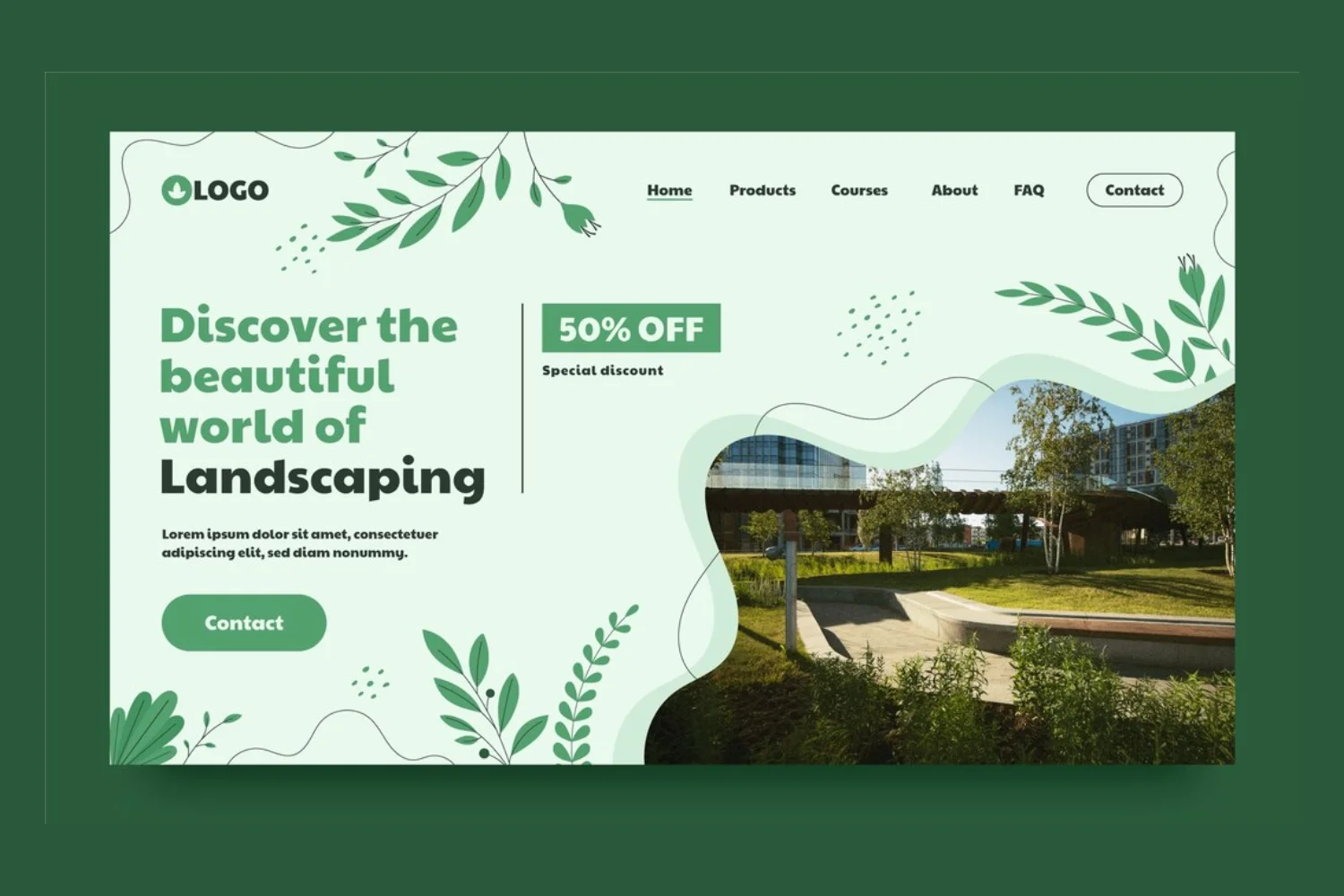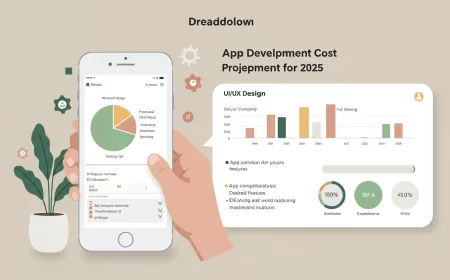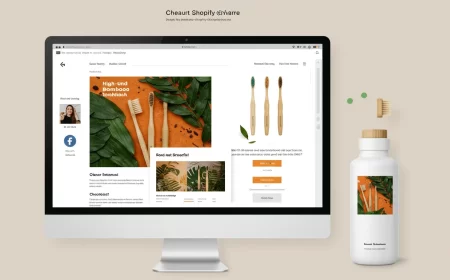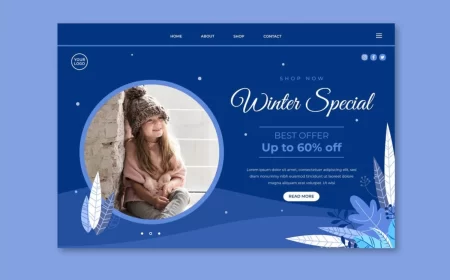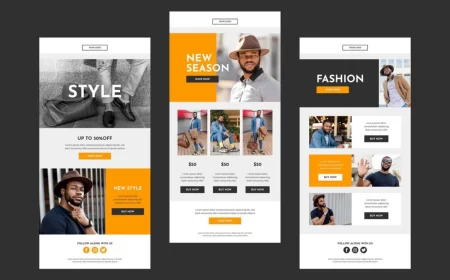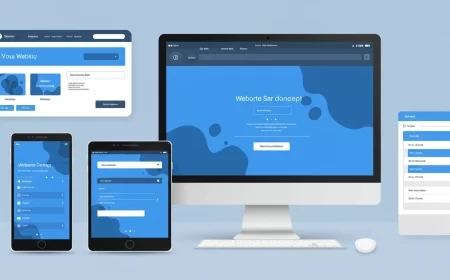In the visually rich world of outdoor design and maintenance, a landscaping website is far more than just a digital business card; it’s your premier outdoor showroom, your client testimonial gallery, and your primary lead generation engine. It’s where the artistry of your designs, the precision of your installations, and the dedication of your maintenance teams are beautifully showcased, allowing potential clients to envision their outdoor spaces transformed. A compelling landscaping website doesn’t just list services; it inspires dreams, builds trust, and provides seamless access for clients to request quotes and book projects.
This comprehensive guide will illuminate the path to creating an impactful landscaping website. We’ll explore why a strong online platform is indispensable for every landscaping business, delve into the essential features that capture attention and convert visitors into leads, offer strategic content ideas to showcase your expertise, and outline best practices for design and usability. We’ll also provide inspiring conceptual examples of what makes a landscaping website truly stand out, helping you to craft an online presence that is as vibrant and meticulously designed as your finished projects.
Why Every Landscaping Company Needs a Powerful Website
The decision to invest in landscaping services often begins with an online search, driven by visual inspiration and a need for reliable professionals. For a landscaping business, a powerful website offers distinct advantages:
- First Impressions & Professionalism: Your website is often the first interaction a potential client has with your company. A professional, visually stunning, and user-friendly site immediately conveys your credibility, attention to detail, and the quality of your work.
- Showcasing Your Portfolio (Before & After): Landscaping is inherently visual. A website provides the perfect canvas to display high-resolution “before & after” photos, demonstrating your transformative capabilities across various projects.
- Lead Generation & Quote Requests: Implement clear forms for clients to request quotes, schedule consultations, or inquire about specific services, streamlining the sales process and capturing valuable leads 24/7.
- Comprehensive Service Menu & Transparency: Clearly list all your services (e.g., design, installation, maintenance, hardscaping, irrigation) with detailed descriptions and transparent pricing structures or consultation options.
- Attracting New Clients (Local SEO): An optimized website helps your company appear prominently in local search results (e.g., “landscapers near me,” “lawn care [your city]”), driving organic traffic and new client acquisition.
- Building Trust & Credibility: Showcase client testimonials, certifications, insurance details, and your company’s history to build rapport and trust with potential clients.
- Educating Clients: Provide information on seasonal care, plant selection, sustainable practices, and project timelines, positioning your company as an expert.
- Competitive Advantage: A superior website can set you apart from competitors who might only rely on basic online listings or social media.
Key Features of an Effective Landscaping Website
A successful landscaping website is a strategic blend of stunning visuals, practical functionality, and clear, persuasive information. Here are the essential features to consider:
- Stunning Before & After Portfolio/Gallery:
- High-Resolution Photos: Professional, well-lit “before & after” shots of various projects (gardens, patios, lawn installations, outdoor living spaces).
- Categorization: Organize projects by service type (e.g., “Landscape Design,” “Hardscaping,” “Lawn Care,” “Seasonal Cleanup”), project size, or style (e.g., “Modern,” “Traditional,” “Drought-Tolerant”).
- Project Details: For each project, include a brief description, location (general area for privacy), and the scope of work.
- Prominent Quote Request Form:
- Easy Access: A highly visible, ideally sticky, “Get a Free Quote” or “Request Consultation” button on every page.
- User-Friendly Fields: Simple form asking for essential details (name, contact, service needed, brief description of project, preferred contact method).
- Response Time: Set clear expectations for when clients can expect a response.
- Comprehensive Service Offerings:
- Clear Categories: Detail all services you provide (e.g., Landscape Design, Installation, Lawn Maintenance, Tree & Shrub Care, Irrigation Systems, Hardscaping, Outdoor Lighting, Seasonal Cleanups).
- Detailed Descriptions: Explain what each service entails, your process, and the benefits to the client.
- Specialty Services: Highlight any unique skills like water features, custom fire pits, or sustainable landscaping.
- Client Testimonials & Reviews:
- Prominent Display: Feature glowing reviews on the homepage or a dedicated “Testimonials” page.
- Authenticity: Include client names (first name and initial of last name for privacy) and, if possible, a photo of the finished project they mention.
- Integration: Link to or embed reviews from Google My Business, Yelp, HomeAdvisor, or Angie’s List.
- “About Us” / Company Story:
- Build Trust: Share your company’s history, mission, values, and what makes your team passionate about transforming outdoor spaces.
- Meet the Team (Optional): Photos and bios of key team members, highlighting their experience, expertise, and dedication.
- Certifications/Insurance: Display badges for licensing, insurance, and relevant certifications (e.g., horticultural, irrigation specialist) to build credibility.
- Contact Information & Service Area:
- Clear Display: Business address (if applicable), phone number, email address, and operating hours.
- Embedded Map: A Google Map for easy directions (if you have a physical office).
- Service Area Map/List: Clearly state the geographic areas you serve, perhaps with an interactive map.
- FAQs Section:
- Address common questions about the landscaping process, project timelines, payment terms, warranties, and seasonal care. This reduces phone inquiries.
- Blog / Resources Section (Optional but Recommended):
- Seasonal Tips: Articles on lawn care tips for spring, winter plant protection, or fall cleanup advice.
- Plant Guides: Information on native plants, drought-tolerant landscaping, or best plants for specific climates.
- Design Inspiration: Blog posts showcasing different landscape styles or outdoor living trends.
- Project Spotlights: In-depth articles on specific challenging or unique projects.
- SEO Benefits: Helps attract organic traffic through relevant content.
- Social Media Integration:
- Mobile Responsiveness:
- Crucial: Most potential clients will access your website on their smartphones while looking at their yard. Ensure it adapts and looks flawless on all devices.
- Search Engine Optimization (SEO):
- Local SEO: Optimize for keywords like “landscaping company [your city],” “lawn care [your neighborhood],” “landscape design [your town].”
- Fast Loading Times: Optimize images and videos for speed.
- Secure (HTTPS): Essential for trust and search rankings.
Content Ideas for Your Landscaping Website
Engaging content is key to converting visitors into booked projects:
- “Our Process” Breakdown: A step-by-step guide to your landscaping process, from initial consultation and design to installation and maintenance, building transparency.
- Plant Library/Guide: A visual database of plants you commonly use, with photos and care instructions.
- Seasonal Maintenance Packages: Clearly outline different seasonal service packages (e.g., spring cleanup, fall leaf removal, winterization).
- “Meet the Crew” Videos: Short videos introducing your landscaping team, highlighting their professionalism and passion.
- Sustainable Landscaping Practices: Detail your commitment to eco-friendly methods, water conservation, and native planting.
- Commercial Project Case Studies: For commercial services, detailed case studies with photos, project scope, and client benefits.
- Warranty/Guarantee Information: Clearly state any warranties or guarantees on your plants or installations.
- Design Consultation Offer: A clear CTA for a free or discounted initial design consultation.
- Partnerships: Highlight collaborations with nurseries, architects, or home builders.
Best Practices for Design & Usability
Your website’s design should be as fresh, vibrant, and meticulously planned as your landscaping projects.
- Visually Driven & Portfolio-First: Landscaping is highly visual! Use large, high-quality “before & after” images and project photos prominently. Your portfolio should be the star.
- Clean & Natural Aesthetic: Avoid clutter. Use ample white space, a color palette inspired by nature (greens, blues, earthy tones), and legible typography that evokes a sense of calm and professionalism.
- Intuitive Navigation: Make it incredibly easy for clients to find your portfolio, services, and quote request form. “Get a Quote” buttons should be highly visible and consistently placed.
- Fast Loading Times: Optimize all image and video assets. Slow sites will deter potential clients.
- Mobile-First Design: Design with smartphones in mind first, then scale up for larger screens.
- Strong Branding: Ensure your logo, colors, and overall visual style are consistent with your company’s physical appearance and marketing materials.
- Clear Calls-to-Action: Guide visitors with prominent buttons for requesting quotes, viewing portfolios, or contacting you.
- Accessibility: Ensure your website is usable by everyone, including those with disabilities (e.g., good color contrast, alt text for images, video captions).
- Regular Updates: Keep your portfolio fresh with new projects, update promotions, and add new blog content to show your company is active and thriving.
Platforms for Building a Landscaping Website
Several user-friendly platforms are ideal for creating a professional landscaping website:
- Website Builders with Service/Booking Features:
- Wix: Offers a user-friendly drag-and-drop interface, many professional templates (including those for home services), and integrated booking/quote request features. Excellent for visual appeal and ease of use.
- Squarespace: Known for its stunning, minimalist templates and strong visual capabilities, ideal for showcasing portfolios. Integrates with Squarespace Scheduling (formerly Acuity Scheduling) for consultations.
- GoDaddy Website Builder: Simple to use, includes built-in appointment scheduling and contact forms. Good for quick setup.
- Weebly: Another intuitive drag-and-drop builder, suitable for creating professional sites with integrated forms.
- WordPress (Self-Hosted with Plugins):
- WordPress.org (requires hosting): Offers maximum flexibility and control. You’d use themes designed for landscaping/home services and plugins for forms (e.g., Contact Form 7, WPForms), galleries (e.g., Envira Gallery), and potentially project management features. Steeper learning curve but highly scalable.
- Lead Generation Focused Platforms:
- HomeAdvisor: Many landscaping companies use platforms like HomeAdvisor or Angie’s List as a primary online presence to generate leads, which can then link to a more detailed personal website.
- Thumbtack: Similar to HomeAdvisor, allows service professionals to connect with local clients seeking specific services.
Conceptual Examples of Effective Landscaping Websites
Here are 30 conceptual examples illustrating different approaches and features you’d find on leading landscaping websites, with external links for inspiration on the type of feature or design element:
Focus on Visual Portfolio & Transformations
- The “Seasonal Transformation Slider”: On the homepage, an interactive slider that allows users to drag a bar across an image to reveal the dramatic “before” and “after” transformation of a landscape project, showcasing seasonal changes.
- Inspiration: See examples of image comparison sliders on TwentyTwenty or CodePen.
- The “Project Showcase by Landscape Style”: A portfolio categorized by specific landscape styles (e.g., “Modern Minimalist,” “Traditional English Garden,” “Drought-Tolerant Oasis,” “Rustic Charm”) allowing clients to find relevant examples.
- Inspiration: Landscape design portfolios on Houzz.
- The “Plant & Material Library”: A visual database of common plants, trees, shrubs, and hardscaping materials you use, with photos, descriptions, and care notes.
- Inspiration: Online plant encyclopedias or material suppliers’ websites.
- The “Drone Footage Project Tours”: Short, professionally shot drone videos showcasing the full scope of larger completed landscape projects, especially those with intricate designs or expansive areas.
- Inspiration: Real estate drone videos on YouTube.
- The “Outdoor Living Space Gallery”: A dedicated portfolio section for patios, decks, outdoor kitchens, fire pits, and other outdoor living installations, inspiring clients to extend their living space.
- Inspiration: Outdoor living design galleries on Pinterest.
Emphasis on Lead Generation & Convenience
- The “Sticky ‘Get a Quote’ Button”: A highly visible, always-present “Get a Free Quote” button that remains fixed as the user scrolls, ensuring easy access to lead generation.
- Inspiration: Many service-based websites use sticky CTAs. See general examples on UX design blogs about sticky elements.
- The “Interactive Service Selector & Quote Form”: A user-friendly form where clients can select services from a list (e.g., “Lawn Mowing,” “Garden Design,” “Irrigation Repair”) and then fill in details for a quote.
- Inspiration: Service booking forms from tools like Jotform.
- The “Online Design Consultation Scheduler”: An integrated calendar system allowing clients to easily book a virtual or in-person design consultation or project assessment.
- Inspiration: Online scheduling tools like Calendly.
- The “Seasonal Service Signup”: A prominent section on the homepage offering quick sign-ups for seasonal services like spring cleanup, fall leaf removal, or winterization.
- Inspiration: Seasonal service promotions on home maintenance websites.
- The “New Client Discount Pop-up”: A subtle pop-up offering a percentage off the first landscaping project or a free initial consultation for new clients, with a direct link to the quote form.
- Inspiration: Marketing pop-up examples from tools like OptinMonster.
Building Trust & Credibility
- The “Client Testimonial Video Reel”: A short compilation video featuring satisfied clients speaking directly about their positive experience with your landscaping company.
- Inspiration: Video testimonials on business websites.
- The “Certifications & Insurance Showcase”: A dedicated section prominently displaying badges for your licenses, insurance, and any industry certifications (e.g., certified landscaper, irrigation specialist).
- Inspiration: “Trust Badges” on professional service websites.
- The “Our Process Explained” Infographic: A visual infographic or animated guide detailing your end-to-end landscaping process, from initial consultation to project completion, building transparency.
- Inspiration: Process infographics from design agencies. See examples on Canva.
- The “Meet the Team” Page with Expertise: Photos and short bios of your key landscapers, designers, and crew leaders, highlighting their experience, specific skills, and passion for outdoor spaces.
- Inspiration: “Meet the Team” pages of local businesses.
- The “Environmental Commitment” Page: Detail your company’s dedication to sustainable landscaping practices, water conservation, native planting, and eco-friendly materials.
- Inspiration: Corporate sustainability reports or eco-conscious brand websites. See Patagonia’s environmental initiatives.
Informative & Educational Content
- The “Seasonal Lawn Care Guide Blog”: A regularly updated blog with articles on specific lawn care tips for each season (e.g., “Spring Fertilization,” “Summer Watering Schedule,” “Fall Aeration”).
- Inspiration: Lawn care blogs like Scotts.
- The “Plant Selection Guide by Region/Climate”: A comprehensive guide explaining the best plants, trees, and shrubs for your specific local climate, soil types, and sun exposure.
- Inspiration: Online plant encyclopedias or local nursery websites.
- The “Hardscaping Material Comparison”: An article or interactive tool comparing different hardscaping materials (e.g., pavers, natural stone, concrete) for patios, walkways, and driveways.
- Inspiration: Home improvement blogs or material supplier websites.
- The “Water Conservation Tips Blog”: Articles on efficient irrigation, drought-tolerant landscaping, and rainwater harvesting techniques.
- Inspiration: Environmental or gardening blogs focusing on water conservation.
- The “FAQ for Landscaping Projects”: A detailed section answering common questions about project timelines, permits, maintenance, and warranties.
- Inspiration: FAQ sections of home service industry websites.
Design & User Experience Focused
- The “Lush & Natural Aesthetic”: A website design with a dominant green and blue color palette, ample white space, and high-quality imagery that evokes a sense of calm, growth, and natural beauty.
- Inspiration: Nature photography websites or environmental organization sites.
- The “Responsive Before & After Slider”: Ensures that your “before & after” image sliders or comparison tools work flawlessly and look great on all mobile devices.
- Inspiration: Responsive image galleries on photography portfolio sites.
- The “Subtle Growth Animations”: Use tasteful, subtle animations (e.g., elements subtly growing into view, leaves rustling on hover) to enhance the user experience without being distracting.
- Inspiration: Creative web design trends showcased on Awwwards.
- The “Embedded Instagram Feed”: A live, scrollable feed of your company’s Instagram posts, showcasing fresh projects, seasonal beauty, and behind-the-scenes glimpses.
- Inspiration: Many business websites embed social feeds. For a general idea, see how Instagram’s embedded feeds work.
- The “High-Quality Photography Focus”: The website prioritizes large, professional photos of completed projects, minimizing text to let the visual transformations speak for themselves.
- Inspiration: Professional photography portfolios or high-end product showcases.
Unique & Creative Concepts
- The “Virtual Landscape Design Tool” (Conceptual): An interactive tool where users can upload a photo of their yard and virtually “try on” different landscaping elements (e.g., trees, shrubs, patio designs).
- Inspiration: Virtual design tools on home improvement or furniture websites.
- The “Client Project Map”: An interactive map showing the general locations of your completed projects (without specific addresses), highlighting your service area and breadth of work.
- Inspiration: Project maps on construction or architecture firm websites.
- The “Testimonial Submission Form with Photo Upload”: An easy-to-use form where happy clients can quickly submit their written testimonials and upload photos of their transformed outdoor space.
- Inspiration: Feedback forms on service websites or testimonial collection tools.
- The “Loyalty/Referral Program Overview”: A page clearly explaining the benefits and mechanics of a loyalty or referral program for repeat clients or those who refer new business.
- Inspiration: Referral program pages from various service businesses. See Dropbox’s referral program.
- The “Seasonal Maintenance Calendar”: An interactive calendar outlining typical landscaping tasks and services recommended for each month of the year in your region.
- Inspiration: Gardening calendars or seasonal home maintenance guides.
G. Advanced & Interactive Elements
- The “Interactive Service Area Map”: A map where users can input their zip code to confirm if they are within your service area, with a clear message for out-of-area inquiries.
- Inspiration: Delivery service websites or local business locators.
- The “Project Cost Estimator”: A simple, interactive tool allowing users to input basic project details (e.g., lawn size, type of service) to get a rough, immediate cost range (with disclaimers).
- Inspiration: Online cost calculators from other service industries.
- The “Live Chat Support”: An integrated live chat feature for immediate customer service or quick questions about services and quotes.
- Inspiration: Live chat services like Intercom or Zendesk Chat.
- The “Downloadable Seasonal Care Guides”: Offer free downloadable PDFs with detailed guides on how to care for lawns, gardens, and plants during different seasons.
- Inspiration: Resource libraries on educational or gardening websites.
- The “Before & After Video Compilation”: A dynamic video showcasing a rapid succession of “before & after” transformations set to uplifting music.
- Inspiration: Transformation videos on social media (e.g., TikTok).
H. Storytelling & Narrative Driven
- The “Our Philosophy in Action” Video: A short, professionally produced video explaining your company’s approach to landscaping, showcasing your team at work and client satisfaction.
- Inspiration: Brand story videos from service companies.
- The “Journey of a Landscape Project”: A detailed case study (blog post or dedicated page) following a single project from initial client vision through design, installation, and final reveal.
- Inspiration: Case study sections on architectural or design firm websites.
- The “Client Success Stories with Testimonial Photos”: Feature longer-form testimonials with accompanying photos of the clients enjoying their newly transformed outdoor space.
- Inspiration: Success story sections on coaching or transformation-focused websites.
- The “Meet the Founder” Story: A personal narrative about the founder’s passion for landscaping, how the company started, and its vision for the future.
- Inspiration: “Founder Story” pages on small business websites.
- The “Why Choose Us” Infographic: A visually engaging infographic highlighting your key differentiators, benefits, and values in an easy-to-digest format.
- Inspiration: Infographics from marketing agencies or business consultants.
I. Niche & Specialty Focus
- The “Drought-Tolerant Landscaping Showcase”: A portfolio specifically dedicated to water-wise and drought-tolerant landscape designs, appealing to environmentally conscious clients.
- Inspiration: Websites of nurseries specializing in xeriscaping or sustainable gardening.
- The “Outdoor Lighting Design Portfolio”: A gallery showcasing stunning nighttime photos of landscapes illuminated by your outdoor lighting installations.
- Inspiration: Outdoor lighting company websites.
- The “Commercial Landscaping Solutions”: A dedicated section for commercial clients, outlining services for businesses, HOAs, and public spaces, with relevant case studies.
- Inspiration: Commercial property management or facility service websites.
- The “Water Features & Pond Design”: A specialized portfolio for custom water features, ponds, and streams, highlighting your expertise in aquatic landscaping.
- Inspiration: Pond and water garden design company websites.
- The “Sustainable Garden Design & Edibles”: Focus on edible landscaping, organic gardening, and creating sustainable food-producing outdoor spaces.
- Inspiration: Permaculture or organic gardening websites.
J. Growth & Marketing Focused
- The “Email Newsletter Signup”: A prominent form or pop-up inviting visitors to subscribe to your email list for seasonal tips, promotions, and updates.
- Inspiration: Email marketing signup forms from services like Mailchimp.
- The “Catering & Events Inquiry Form”: A dedicated form for businesses or individuals interested in booking your cafe for catering or private events.
- Inspiration: Catering service websites.
- The “Job Opportunities” Section: A link to a careers page for those interested in joining your team, showcasing your company as a great place to work.
- Inspiration: “Careers” pages on company websites.
- The “Partnership Opportunities” Page: A page for potential collaborators (e.g., architects, real estate agents, home builders) to learn about partnering with your landscaping company.
- Inspiration: Partnership pages on business development sites.
- The “Press Kit” Download: A small link to a downloadable press kit with your logo, high-res project photos, and company boilerplate for media inquiries.
- Inspiration: Press sections on corporate websites.
- The “Featured Blog Post Carousel”: A rotating display of your latest blog posts or seasonal guides, encouraging visitors to explore more content.
- Inspiration: Blog sections on home and garden websites.
- The “Seasonal Promotion Banner”: A dynamic banner at the top of the homepage highlighting current seasonal services (e.g., “Winter Snow Removal,” “Spring Lawn Aeration”) with a direct link to book.
- Inspiration: Promotional banners on e-commerce sites.
- The “Online Gift Certificate Purchase”: A clear and easy process for customers to buy digital or physical gift certificates for landscaping services.
- Inspiration: Gift certificate purchase flows on major service retail websites.
- The “Customer Photo Submission”: Encourage clients to submit photos of their completed projects for your gallery, fostering engagement and providing fresh content.
- Inspiration: User-generated content submission forms on community sites.
- The “Virtual Consultation Offer”: A prominent call-to-action for a virtual initial consultation, especially useful for clients who are busy or located further away.
- Inspiration: Virtual consultation offers from other professional service providers.
Conclusion
A meticulously designed and strategically implemented landscaping website is an indispensable asset for any modern outdoor design and maintenance business. It extends your company’s reach beyond local word-of-mouth, offering unparalleled visual proof of your craftsmanship, streamlining the quote request process, and building lasting relationships through transparent communication and an inspiring brand identity. By investing in a powerful online presence that reflects the quality and artistry of your services, you can attract new clients, enhance client loyalty, and ensure your landscaping company continues to thrive in a competitive digital landscape.
Frequently Asked Questions (FAQs)
Q1: What is the most important feature for a landscaping website?
The most important feature is a high-quality, easily accessible “Before & After” portfolio or gallery. Landscaping is a highly visual service, and potential clients need to see tangible proof of your transformative capabilities and the stunning results you deliver.
Q2: Do I need professional photos for my landscaping website?
Absolutely yes. Professional, high-resolution “before & after” photos, as well as photos of your team at work and various design elements, are non-negotiable. They are your primary visual marketing tool and convey your professionalism, attention to detail, and the beauty of your finished projects.
Q3: Should I include pricing for my services on my website?
While exact fixed pricing can be difficult for custom landscaping projects, transparency is key. You can provide “starting from” prices for common maintenance services or clearly state that quotes are free and provide a prominent “Request a Quote” form. This helps qualify leads and manages expectations.
Q4: How often should I update my landscaping website?
You should update your website regularly. This includes:
- Adding new “before & after” projects to your portfolio (as often as new projects are completed).
- Updating seasonal promotions and special offers.
- Posting new blog content (monthly), especially seasonal tips.
- Ensuring your service menu and contact information are always current.
Q5: Can a landscaping website help with local SEO?
Yes, significantly. Optimize your site for local keywords (e.g., “landscaping company [your city/neighborhood],” “lawn care [your town],” “landscape design [your area]”). Ensure your Google My Business profile is linked and consistent. Fast loading times, mobile responsiveness, and a secure (HTTPS) site also contribute to better local search rankings.
Q6: What’s the best way to get client testimonials for my website?
Actively ask satisfied clients for testimonials after a project is completed. Make it easy for them by providing a direct link to a review platform (Google My Business, Yelp) or a simple form on your website. If possible, ask for a photo of their transformed outdoor space or even a short video testimonial.
Q7: Should I have a blog on my landscaping website?
Yes, a blog is highly recommended. It helps with SEO by providing fresh, relevant content for search engines. It also allows you to:
- Share valuable tips on plant care, seasonal maintenance, and design inspiration.
- Showcase your expertise and professionalism.
- Answer common client questions in detail, reducing direct inquiries.
- Build trust and position your company as a knowledgeable resource in outdoor living.

